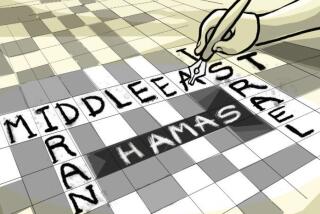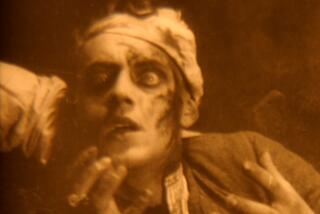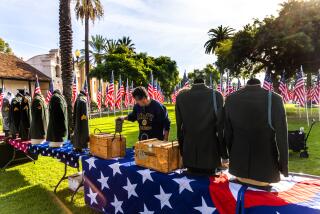Soldiers, Grenade Launchers--but Some Nudes Too : War Is a Subject for Iraqi Art Students
BAGHDAD, Iraq — A soldier peers motionlessly through the scope of a rocket-propelled grenade launcher; another is depicted reeling in agony as a bullet pierces his chest.
Nearby, several art students chat casually, apparently oblivious to the plaster and papier-mache battleground of art on display in the courtyard of the Iraqi Academy of Fine Arts.
“I don’t encourage this type of art,” says Ismail Fattah Turk, an Italian-educated professor at the academy and designer of the national martyrs’ monument here.
“I teach differently. I teach them to be free in form as well as academic discipline,” he explains. “But right now, they are concerned with the (Iran-Iraq) war. This is how they want to express themselves.”
Turk says that although most of his students have been directly affected by the war--the males as soldiers and the females as daughters, sisters or cousins of soldiers--some have chosen forms of expression other than “war art.”
He smiles at the mention of the few nude sculptures at the academy. “We like to do nudes. We like them, but of course we don’t use real models, only pictures,” he says. “We are religious people, but we don’t let this close our minds.”
Turk is on a committee of five artists chosen to select for public display the best of the works submitted on Iraq’s most popular art subject: President Saddam Hussein, whose portraits are displayed throughout the country.
He frowns at a suggestion that perhaps some of the works go overboard, such as one at the monument depicting a helmeted Hussein charging the war front with an assault rifle or another showing him thrashing wheat with a group of peasants.
Turk says he chooses symbolism over realism in his own art, and he proudly explains the meaning behind his martyrs’ monument.
It consists of two tulip-shaped, turquoise half-domes slightly offset from each other. At the base of one is a fountain, and at the base of the other is an Iraqi flag shaped as if it shrouds a standing man.
“The split in the domes symbolizes the moment of death, the opening of heaven. The flag symbolizes the spirit of the martyr, who died for his beliefs, in defense of his religion, his country, his family,” Turk says.
Designed Before War
He says he designed the monument in 1978, not anticipating the Persian Gulf War, which erupted in 1980 and which has caused hundreds of thousands of deaths on both sides.
Hussein, who personally selected Turk’s design and told him to spare no cost in its construction, has declared the 135-foot-tall monument sacred ground, Turk says.
Only official guests are allowed to walk at the base of the domes. Following the example of Hussein when he unveiled it in 1983, visitors must remove their shoes.
Turk contrasts the monument with Tehran’s martyrs’ monument, a fountain that spews blood-red water.
“I chose water instead of blood, because water is the symbol of life. I wish the world could come and compare these two monuments. It would say a lot about our different outlooks on war and life--our entire characters.”
More to Read
Sign up for Essential California
The most important California stories and recommendations in your inbox every morning.
You may occasionally receive promotional content from the Los Angeles Times.










